Paper Menu >>
Journal Menu >>
 Energy and Power Engineering, 2013, 5, 651-656 doi:10.4236/epe.2013.54B126 Published Online July 2013 (http://www.scirp.org/journal/epe) Study on Operating Characteristics of Power Plant with Dry and Wet Co o l ing System s Tao Tang1, Jian-qun Xu1*, Sheng-xiang Jin2, Hong-qi Wei1 1School of Energy and Environment, Southeast University, Nanjing, China 2Beijing Energy Company Limited, Beijing, China Email: tangtao_1026@163.com, *qlj1062@163.com Received February, 2013 ABSTRACT The represent paper will study the performance of the power plant with the combination of dry and wet cooling systems in different operating conditions. A thermodynamic performance analysis of the steam cycle system was performed by means of a program code dedicated to power plant modeling in design operating condition. Then the off-design behav- ior was studied by varying not only the ambient temperature and relative humidity but also several parameters con- nected to the cooling performance, like the exhaust steam flow rate, the air cooling fan load and the number of operat- ing cooling water pumps and cooling towers. The result is an optimum set of variables allowing the dry and wet cooling system be regulated in such a way that the maximum power is achieved and low water consumption. Keywords: Dry and Wet Condenser; Cooling Tower; Off-design; Characteristic Curve; Operational Optimization 1. Introduction There are three ways of thermal power plants’ cooling systems: dry cooling system, wet cooling system, and dry and wet cooling system. In China, the wet cooling system use in the power plans commonly, but in the northwest and northeast China where the water is shortage use air cooling system. The wet cooling systems have high thermal economy, but with high water consumption. The air cooling systems can save a lot of water, but the ex- haust steam pressure is high and varying all the time for the impact of ambient temperature [1]. The wet and dry cooling systems combines the both advantages, it not only make full power when the ambient temperature is high but also with low water consumption [2,3]. The present study was inspired by the operation of a power plant with the combined wet and dry cooling sys- tem (Figure 1), placed in Northwest China. The wet and dry cooling system is composed of an air cooled con- denser in parallel with a water cooled condenser. In the wet cooling system, the cooling water which shared by two 300 MW Units, taken from the condenser passes through four wet mechanical draft cooling towers and returns to the condenser by two cooling water pumps. The off-design performance of an air cooling con- denser or water cooling condenser separately is well deeply investigated [4-6], but the study on the perform- ance of complies wet and dry cooling system is rarely find. So the critical element of this study is the wet me- chanical draft tower. The heat transfer in cooling tower is a very complex phenomenon. But it could be described by several equations [7-9] with some simplifying as- sumptions. The purpose of the present paper is to explore the im- pact of a dry and wet cooling system on the thermo-dy- namic performance of a power plant. This paper offers an original contribution for cooling system performance analysis by considering the dry and wet system together. 2. Mathematical Model of Direct Air Cooling System 2.1. The Pressure of Air Condenser Using η-NTU method to calculate the condensate tem- perature of air condenser [1]: ' 11 () 1 1 cc c s a NTU yfyfa p Dh h tt Sv ce (1) Figure 1. Schematic of the wet and dry cooling systems. Copyright © 2013 SciRes. EPE 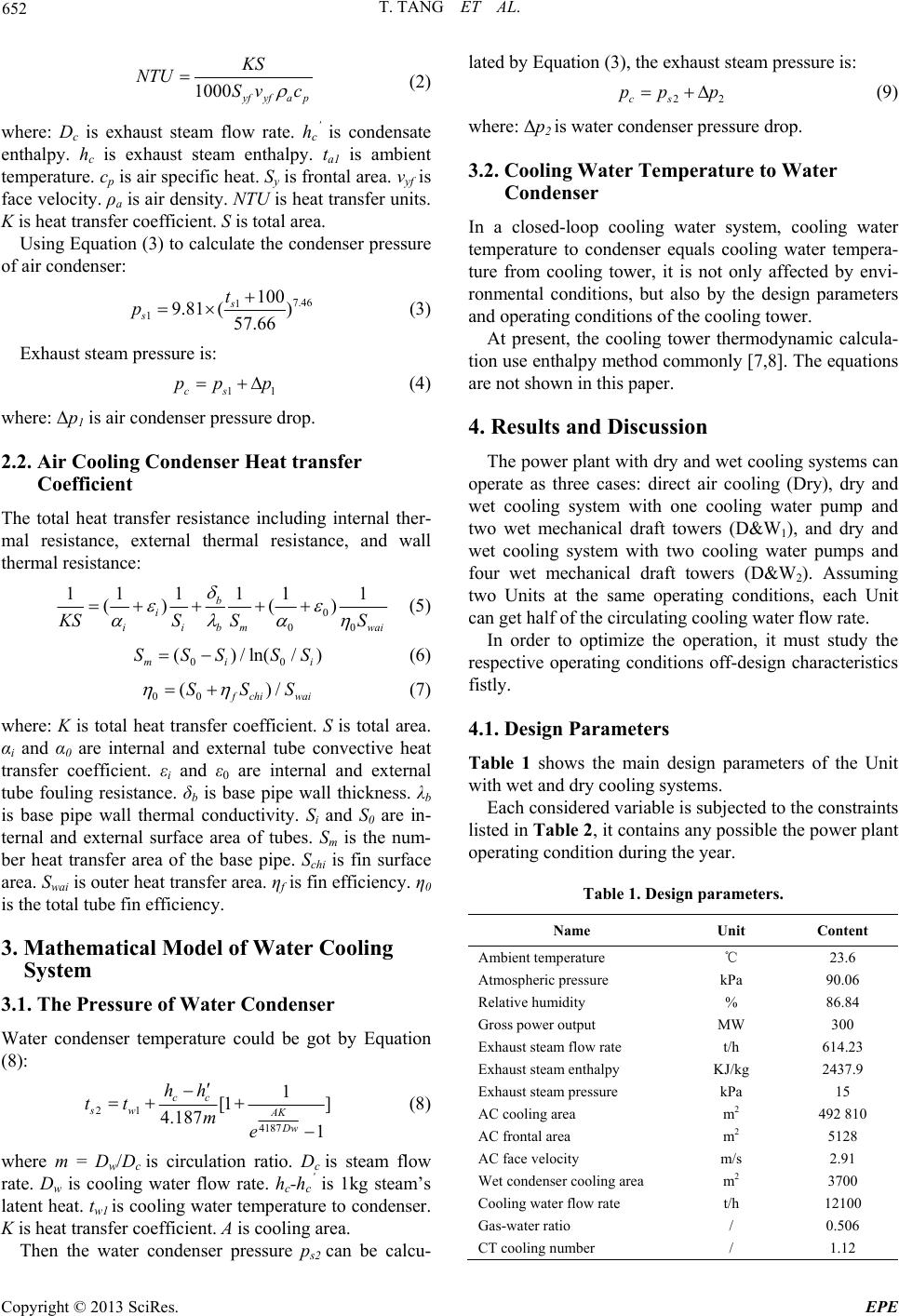 T. TANG ET AL. 652 1000yfyfa p KS NTU Sv c (2) where: Dc is exhaust steam flow rate. hc ’ is condensate enthalpy. hc is exhaust steam enthalpy. ta1 is ambient temperature. cp is air specific heat. Sy is frontal area. vyf is face velocity. ρa is air density. NTU is heat transfer units. K is heat transfer coefficient. S is total area. Using Equation (3) to calculate the condenser pressure of air condenser: 7.46 1 1 100 9.81 () 57.66 s s t p (3) Exhaust steam pressure is: 1cs pp p 1 (4) where: Δp1 is air condenser pressure drop. 2.2. Air Cooling Condenser Heat transfer Coefficient The total heat transfer resistance including internal ther- mal resistance, external thermal resistance, and wall thermal resistance: 0 00 11 1111 ()( ) b i iibm wai K SSS S ) i (5) 00 ()/ln(/ mi SSS SS (6) 00 ()/ f chi wai SSS (7) where: K is total heat transfer coefficient. S is total area. αi and α0 are internal and external tube convective heat transfer coefficient. εi and ε0 are internal and external tube fouling resistance. δb is base pipe wall thickness. λb is base pipe wall thermal conductivity. Si and S0 are in- ternal and external surface area of tubes. Sm is the num- ber heat transfer area of the base pipe. Schi is fin surface area. Swai is outer heat transfer area. ηf is fin efficiency. η0 is the total tube fin efficiency. 3. Mathematical Model of Water Cooling System 3.1. The Pressure of Water Condenser Water condenser temperature could be got by Equation (8): 21 4187 1 [1 ] 4.187 1 cc sw AK Dw hh tt me (8) where m = Dw/Dc is circulation ratio. D c is steam flow rate. Dw is cooling water flow rate. hc-hc ’ is 1kg steam’s latent heat. tw1 is cooling water temperature to condenser. K is heat transfer coefficient. A is cooling area. Then the water condenser pressure ps2 can be calcu- lated by Equation (3), the exhaust steam pressure is: 2cs pp p 2 (9) where: Δp2 is water condenser pressure drop. 3.2. Cooling Water Temperature to Water Condenser In a closed-loop cooling water system, cooling water temperature to condenser equals cooling water tempera- ture from cooling tower, it is not only affected by envi- ronmental conditions, but also by the design parameters and operating conditions of the cooling tower. At present, the cooling tower thermodynamic calcula- tion use enthalpy method commonly [7,8]. The equations are not shown in this paper. 4. Results and Discussion The power plant with dry and wet cooling systems can operate as three cases: direct air cooling (Dry), dry and wet cooling system with one cooling water pump and two wet mechanical draft towers (D&W1), and dry and wet cooling system with two cooling water pumps and four wet mechanical draft towers (D&W2). Assuming two Units at the same operating conditions, each Unit can get half of the circulating cooling water flow rate. In order to optimize the operation, it must study the respective operating conditions off-design characteristics fistly. 4.1. Design Parameters Table 1 shows the main design parameters of the Unit with wet and dry cooling systems. Each considered variable is subjected to the constraints listed in Table 2, it contains any possible the power plant operating condition during the year. Table 1. Design parameters. Name Unit Content Ambient temperature ℃ 23.6 Atmospheric pressure kPa 90.06 Relative humidity % 86.84 Gross power output MW 300 Exhaust steam flow rate t/h 614.23 Exhaust steam enthalpy KJ/kg 2437.9 Exhaust steam pressure kPa 15 AC cooling area m2 492 810 AC frontal area m2 5128 AC face velocity m/s 2.91 Wet condenser cooling area m2 3700 Cooling water flow rate t/h 12100 Gas-water ratio / 0.506 CT cooling number / 1.12 Copyright © 2013 SciRes. EPE 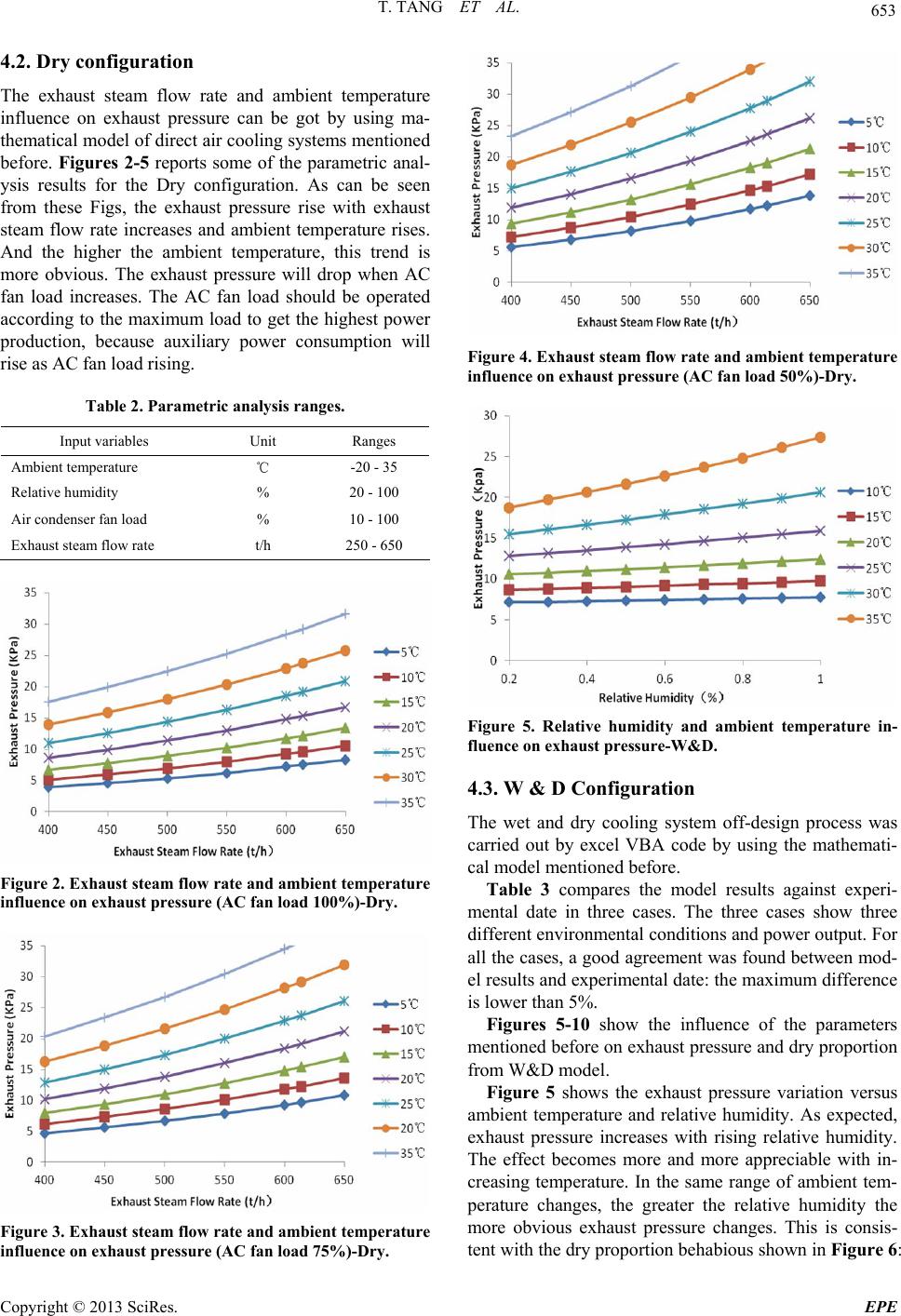 T. TANG ET AL. 653 4.2. Dry configuration The exhaust steam flow rate and ambient temperature influence on exhaust pressure can be got by using ma- thematical model of direct air cooling systems mentioned before. Figures 2-5 reports some of the parametric anal- ysis results for the Dry configuration. As can be seen from these Figs, the exhaust pressure rise with exhaust steam flow rate increases and ambient temperature rises. And the higher the ambient temperature, this trend is more obvious. The exhaust pressure will drop when AC fan load increases. The AC fan load should be operated according to the maximum load to get the highest power production, because auxiliary power consumption will rise as AC fan load rising. Table 2. Parametric analysis ranges. Input variables Unit Ranges Ambient temperature ℃ -20 - 35 Relative humidity % 20 - 100 Air condenser fan load % 10 - 100 Exhaust steam flow rate t/h 250 - 650 Figure 2. Exhaust steam flow rate and ambient temperature influence on exhaust pressure (AC fan load 100%)-Dry. Figure 3. Exhaust steam flow rate and ambient temperature influence on exhaust pressure (AC fan load 75%)-Dry. Figure 4. Exhaust steam flow rate and ambient temperature influence on exhaust pressure (AC fan load 50%)-Dry. Figure 5. Relative humidity and ambient temperature in- fluence on exhaust pressure-W&D. 4.3. W & D Configuration The wet and dry cooling system off-design process was carried out by excel VBA code by using the mathemati- cal model mentioned before. Table 3 compares the model results against experi- mental date in three cases. The three cases show three different environmental conditions and power output. For all the cases, a good agreement was found between mod- el results and experimental date: the maximum difference is lower than 5%. Figures 5-10 show the influence of the parameters mentioned before on exhaust pressure and dry proportion from W&D model. Figure 5 shows the exhaust pressure variation versus ambient temperature and relative humidity. As expected, exhaust pressure increases with rising relative humidity. The effect becomes more and more appreciable with in- creasing temperature. In the same range of ambient tem- perature changes, the greater the relative humidity the more obvious exhaust pressure changes. This is consis- tent with the dry proportion behabious shown in Figure 6: Copyright © 2013 SciRes. EPE 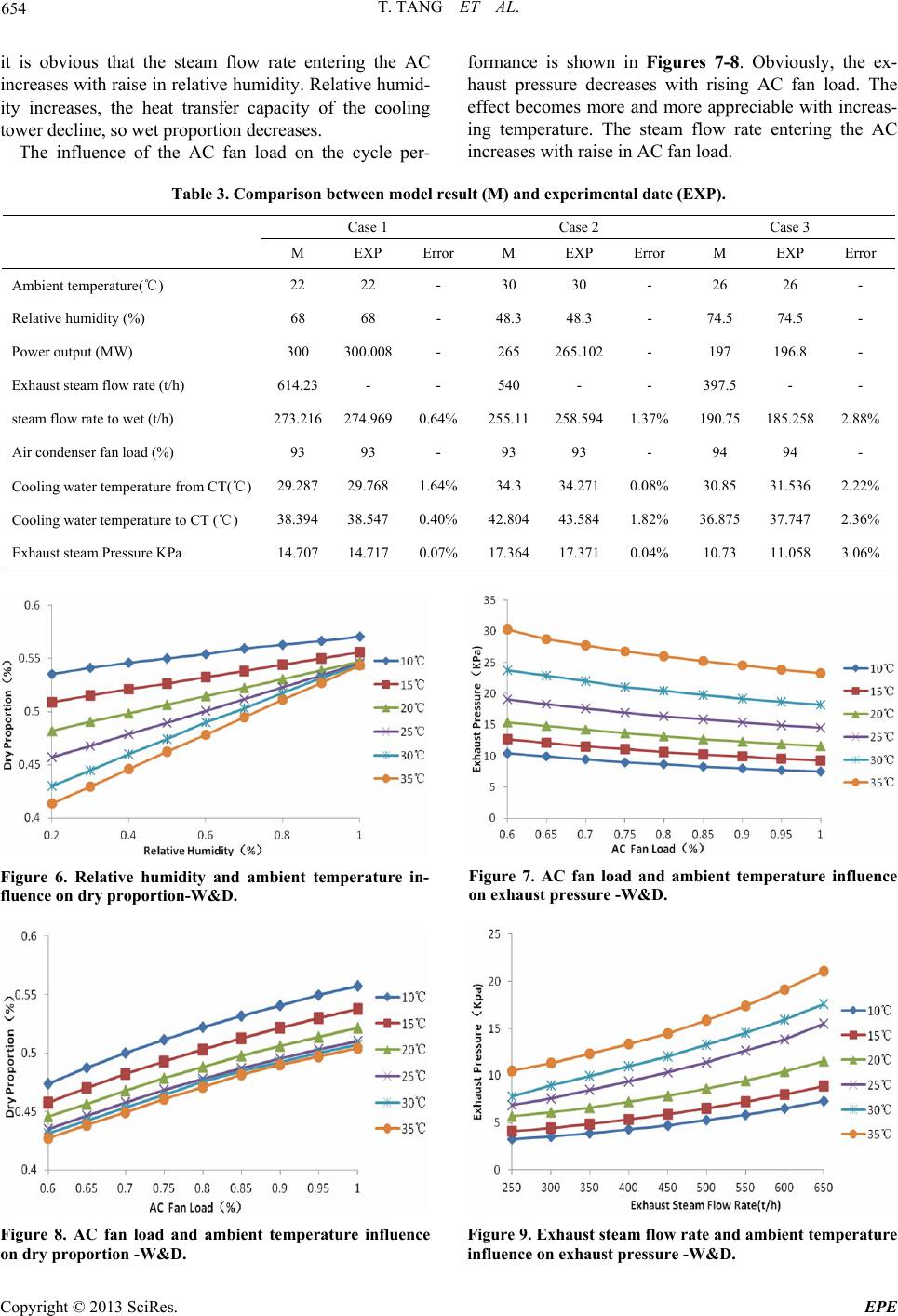 T. TANG ET AL. Copyright © 2013 SciRes. EPE 654 it is obvious that the steam flow rate entering the AC increases with raise in relative humidity. Relative humid- ity increases, the heat transfer capacity of the cooling tower decline, so wet proportion decreases. The influence of the AC fan load on the cycle per- formance is shown in Figures 7-8. Obviously, the ex- haust pressure decreases with rising AC fan load. The effect becomes more and more appreciable with increas- ing temperature. The steam flow rate entering the AC increases with raise in AC fan load. Table 3. Comparison between model result (M) and experimental date (EXP). Case 1 Case 2 Case 3 M EXP Error M EXP Error M EXP Error Ambient temperature(℃) 22 22 - 30 30 - 26 26 - Relative humidity (%) 68 68 - 48.3 48.3 - 74.5 74.5 - Power output (MW) 300 300.008- 265 265.102- 197 196.8 - Exhaust steam flow rate (t/h) 614.23 - - 540 - - 397.5 - - steam flow rate to wet (t/h) 273.216 274.9690.64% 255.11 258.5941.37% 190.75 185.2582.88% Air condenser fan load (%) 93 93 - 93 93 - 94 94 - Cooling water temperature from CT(℃) 29.287 29.768 1.64% 34.3 34.271 0.08% 30.85 31.536 2.22% Cooling water temperature to CT (℃) 38.394 38.547 0.40% 42.804 43.584 1.82% 36.875 37.747 2.36% Exhaust steam Pressure KPa 14.707 14.717 0.07% 17.364 17.371 0.04% 10.73 11.058 3.06% Figure 7. AC fan load and ambient temperature influence on exhaust pressure -W&D. Figure 6. Relative humidity and ambient temperature in- fluence on dry proportion-W&D. Figure 9. Exhaust steam flow rate and ambient temperature influence on exhaust pressure -W&D. Figure 8. AC fan load and ambient temperature influence on dry proportion -W&D. 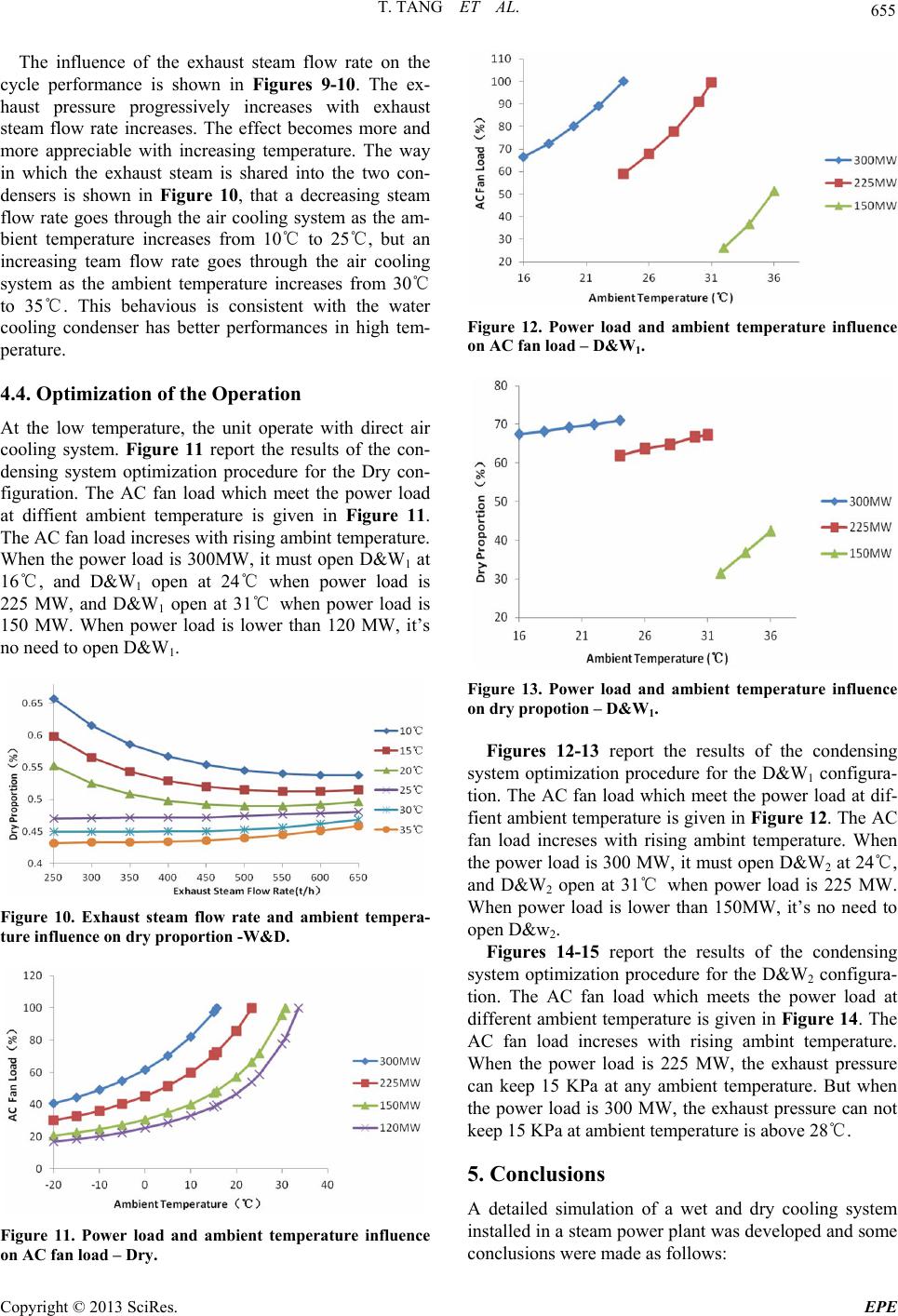 T. TANG ET AL. 655 The influence of the exhaust steam flow rate on the cycle performance is shown in Figures 9-10. The ex- haust pressure progressively increases with exhaust steam flow rate increases. The effect becomes more and more appreciable with increasing temperature. The way in which the exhaust steam is shared into the two con- densers is shown in Figure 10, that a decreasing steam flow rate goes through the air cooling system as the am- bient temperature increases from 10℃ to 25℃, but an increasing team flow rate goes through the air cooling system as the ambient temperature increases from 30℃ to 35℃. This behavious is consistent with the water cooling condenser has better performances in high tem- perature. 4.4. Optimization of the Operation At the low temperature, the unit operate with direct air cooling system. Figure 11 report the results of the con- densing system optimization procedure for the Dry con- figuration. The AC fan load which meet the power load at diffient ambient temperature is given in Figure 11. The AC fan load increses with rising ambint temperature. When the power load is 300MW, it must open D&W1 at 16℃, and D&W1 open at 24℃ when power load is 225 MW, and D&W1 open at 31℃ when power load is 150 MW. When power load is lower than 120 MW, it’s no need to open D&W1. Figure 10. Exhaust steam flow rate and ambient tempera- ture influence on dry proportion -W&D. Figure 11. Power load and ambient temperature influence Figure 12. Power load and ambient temperature influence on AC fan load – D&W1. Figure 13. Power load and ambient temperature influenc Figures 12-13 report the results of the condensing sy -15 report the results of the condensing sy 5. Conclusions on of a wet and dry cooling system e on dry propotion – D&W1. stem optimization procedure for the D&W1 configura- tion. The AC fan load which meet the power load at dif- fient ambient temperature is given in Figure 12. The AC fan load increses with rising ambint temperature. When the power load is 300 MW, it must open D&W2 at 24℃, and D&W2 open at 31℃ when power load is 225 MW. When power load is lower than 150MW, it’s no need to open D&w2. Figures 14 stem optimization procedure for the D&W2 configura- tion. The AC fan load which meets the power load at different ambient temperature is given in Figure 14. The AC fan load increses with rising ambint temperature. When the power load is 225 MW, the exhaust pressure can keep 15 KPa at any ambient temperature. But when the power load is 300 MW, the exhaust pressure can not keep 15 KPa at ambient temperature is above 28℃. A detailed simulati installed in a steam power plant was developed and some conclusions were made as follows: on AC fan load – Dry. Copyright © 2013 SciRes. EPE 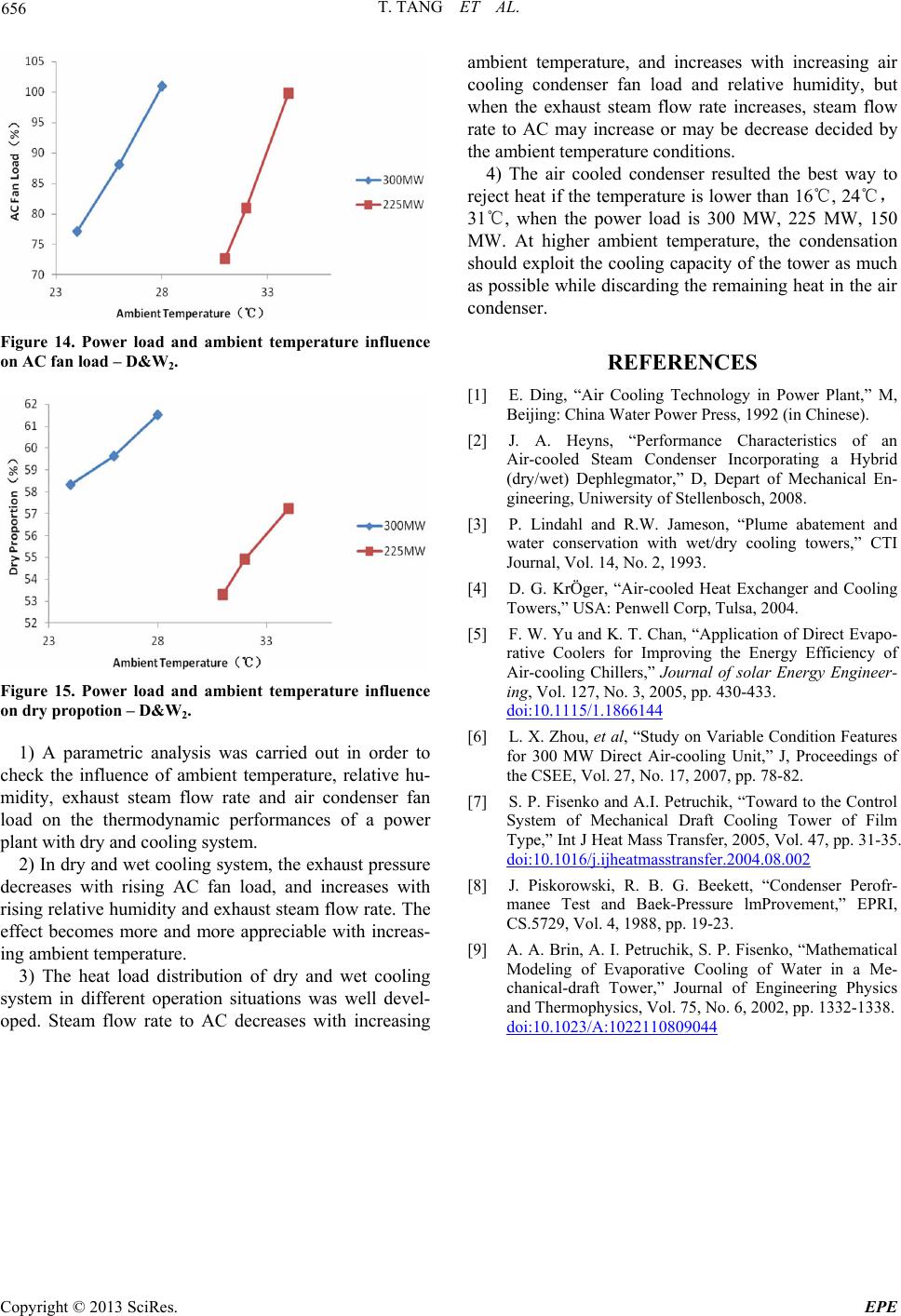 T. TANG ET AL. Copyright © 2013 SciRes. EPE 656 Figure 14. Power load and ambient temperature influence on AC fan load – D&W2. Figure 15. Power load and ambient temperature influenc 1) A parametric analysis was carried out in order to ch , the exhaust press de ution of dry and wet cooling sy decrease decided by th hile discarding the remaining heat in the air condenser. M, hanical En- dry cooling towers,” CTI and Cooling ergy Engineer- 5, pp. 430-433. e on dry propotion – D&W2. eck the influence of ambient temperature, relative hu- midity, exhaust steam flow rate and air condenser fan load on the thermodynamic performances of a power plant with dry and cooling system. 2) In dry and wet cooling systemure creases with rising AC fan load, and increases with rising relative humidity and exhaust steam flow rate. The effect becomes more and more appreciable with increas- ing ambient temperature. 3) The heat load distrib stem in different operation situations was well devel- oped. Steam flow rate to AC decreases with increasing ambient temperature, and increases with increasing air cooling condenser fan load and relative humidity, but when the exhaust steam flow rate increases, steam flow rate to AC may increase or may be e ambient temperature conditions. 4) The air cooled condenser resulted the best way to reject heat if the temperature is lower than 16℃, 24℃, 31℃, when the power load is 300 MW, 225 MW, 150 MW. At higher ambient temperature, the condensation should exploit the cooling capacity of the tower as much as possible w REFERENCES [1] E. Ding, “Air Cooling Technology in Power Plant,” Beijing: China Water Power Press, 1992 (in Chinese). [2] J. A. Heyns, “Performance Characteristics of an Air-cooled Steam Condenser Incorporating a Hybrid (dry/wet) Dephlegmator,” D, Depart of Mec gineering, Uniwersity of Stellenbosch, 2008. [3] P. Lindahl and R.W. Jameson, “Plume abatement and water conservation with wet/ Journal, Vol. 14, No. 2, 1993. [4] D. G. KrÖger, “Air-cooled Heat Exchanger Towers,” USA: Penwell Corp, Tulsa, 2004. [5] F. W. Yu and K. T. Chan, “Application of Direct Evapo- rative Coolers for Improving the Energy Efficiency of Air-cooling Chillers,” Journal of solar En ing, Vol. 127, No. 3, 200 doi:10.1115/1.1866144 [6] L. X. Zhou, et al, “Study on Variable Condition Features for 300 MW Direct Air-cooling Unit,” J, Proceedings of , pp. 31-35. the CSEE, Vol. 27, No. 17, 2007, pp. 78-82. [7] S. P. Fisenko and A.I. Petruchik, “Toward to the Control System of Mechanical Draft Cooling Tower of Film Type,” Int J Heat Mass Transfer, 2005, Vol. 47 doi:10.1016/j.ijheatmasstransfer.2004.08.002 [8] J. Piskorowski, R. B. G. Beekett, “Condenser Perofr- manee Test and Baek-Pressure lmProvement,” EPRI, . 6, 2002, pp. 1332-1338. doi:10.1023/A:1022110809044 CS.5729, Vol. 4, 1988, pp. 19-23. [9] A. A. Brin, A. I. Petruchik, S. P. Fisenko, “Mathematical Modeling of Evaporative Cooling of Water in a Me- chanical-draft Tower,” Journal of Engineering Physics and Thermophysics, Vol. 75, No |

